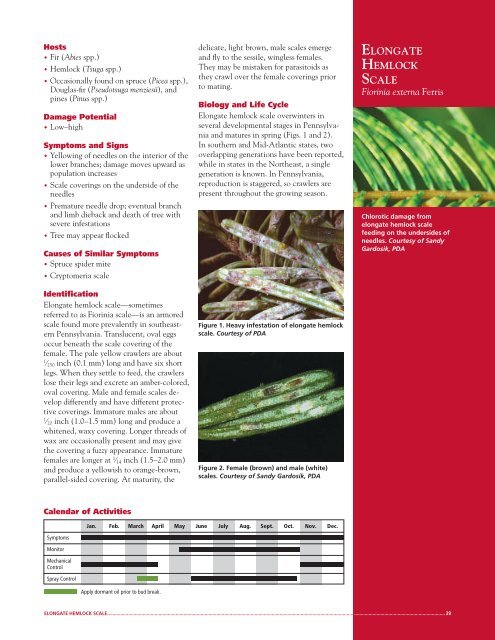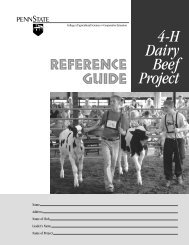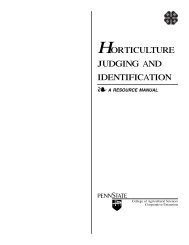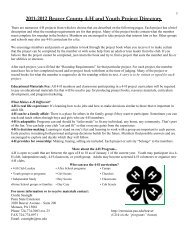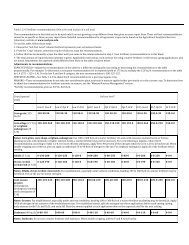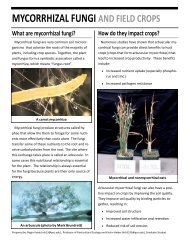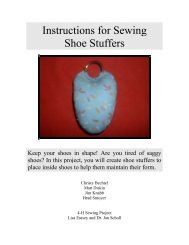Elongate Hemlock Scale - Penn State Extension
Elongate Hemlock Scale - Penn State Extension
Elongate Hemlock Scale - Penn State Extension
You also want an ePaper? Increase the reach of your titles
YUMPU automatically turns print PDFs into web optimized ePapers that Google loves.
Figure 3. Female scales andmobile yellow crawlers on theneedles. Courtesy of SandyGardosik, PDAFigure 4. Chlorotic scale feedingdamage on grand fir. Courtesyof Cathy Thomas, PDAFigure 5. Female elongatehemlock scale. Courtesy ofSandy Gardosik, PDAThe fi rst egg hatch generally starts inlate May or early June. Mobile crawlersmove from under the female’s covering tothe underside of needles (Fig. 3) and beginto feed by inserting their piercing-suckingmouthparts. This feeding causes chlorotic,or yellow, spotting on the upper needlesurface (Fig. 4). At the same time, thecrawlers begin to secrete a translucent,waxy covering. Mature females are presentabout 6–8 weeks after emerging (Fig. 5).Male scales molt an additional time beforethe winged stage emerges (Figs. 6 and 7).Following mating, the males die and thefemale begins to produce about 12–16 eggsunder her armored covering (Fig. 8) As aresult of the various overwintering stages in<strong>Penn</strong>sylvania, crawlers emerge throughoutthe growing season, making repeatedcontrol efforts a necessity.Figure 7. Adult male elongate hemlockscale. Courtesy of Jim Stimmel, PDAMonitoring and ManagementStrategiesPlantation Establishment• Plant tree species that are not susceptibleto elongate hemlock scale.• Properly space trees when planting tominimize infestation from tree to tree andenable thorough coverage if chemicalcontrols are used.• Weed management is important to exposelower branches for ease of detection andeffective control.• Remove and destroy any mature host treesthat may serve as source of infestation.(Canada hemlock is a common host in<strong>Penn</strong>sylvania.)Preseason• Limit the use of nitrogen fertilizers; nitrogenenhances survival and developmentalrate of scales.• Scout for elongate hemlock scale on theunderside of needles. Note: Sometimesa combined population of Cryptomeriascale, balsam woolly adelgid, and hemlockscale can be found on the same trees.• If only a few infested trees are found,removing and destroying them before budbreak may prevent a serious infestationfrom developing.• If numerous infested trees are located, taga few to use for observations of crawleremergence.• Place sticky cards on branches showingsymptoms to trap adult male scale insects(Fig. 9). Their emergence signals that eggswill soon follow.Figure 6. Immature maleelongate hemlock scales.Courtesy of Sandy Gardosik,PDAFigure 8. Eggs inside the overturned femaleelongate hemlock scale casing. Courtesy ofSandy Gardosik, PDAFigure 9. Yellow sticky cards used to attractthe emerging male elongate hemlock scales.Courtesy of Cathy Thomas, PDANEEDLE DISCOLORATION AND INJURY ................................................................................................................................................................................................................................................ 40
Growing Season• Starting in mid-May, scout tagged treesevery few days to check for crawleremergence.• Growing degree days: Crawlers are activefrom 360 to 700 GDDs.• Threshold level: No specifi c thresholdlevel exists at this time. However, diebackof major limbs tends to occur by the timethe population reaches ten scales perneedle.• Continue scouting for crawlers everyfew weeks to determine the need foradditional controls.• At the end of the season, evaluate resultsand update records.Control OptionsBiological• Encourage natural predators such aslady beetles, parasitic wasps, and severallacewing species.• Avoid applications of broad-spectruminsecticides that will kill naturalpredators.Mechanical• Remove and destroy heavily infested treesbefore bud break. Wrap trees in a tarp/plastic when dragging them through thefi eld to prevent transferring scales to othertrees.• Clean mower blades or tractors whenmoving them from an infected fi eld to anuninfected fi eld.• Butt-prune infested trees to remove themost heavily infested lower branches.Biorational• No recommendations are availableat this time.Chemical• Horticultural oil may be applied duringthe growing season. Use lower rate toavoid damage to new growth or wait toapply until new growth has hardened off.• When fi rst crawlers are active, apply asystemic insecticide spray three to fourtimes over a 12-week period (three spraysfour weeks apart or four sprays three weeksapart). Do not apply more than four timesper season.• Evaluate each application to determinethe need for subsequent sprays.Next Crop/Prevention• Purchase and plant scale-free nurserystock from a reputable company.ELONGATE HEMLOCK SCALE ................................................................................................................................................................................................................................................................. 41


